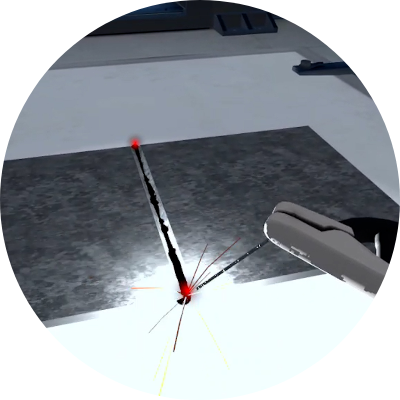 Loading...
Loading...
Initial language selection is based on your web browser preferences.

12MB
Free
Learn various core techniques to work safely and skillfully in a welding environment. In this VR simulation, students complete training in a realistic shop setting, starting with personal protective equipment before moving on to industry-standard welding methods. Each task introduces foundational skills aligned to NCCER certification pathways, supported by accurate representations of tools and materials. **Key features:** - Aligned to NCCER Welding Level 1 standards - Covers PPE, equipment handling and foundational welding processes - Develops key skills for pre-apprenticeship and early technical training ## Course Content: This course consists of one module containing four lessons. **Video Playlist** This VR simulation is accompanied by a curated playlist of short videos that explore the history, safety and regulations of technology. Consider selecting a few videos for students to watch before or during the experience to reinforce their understanding. To access this video content, please log in to your [Victory XR online portal](https://account.victoryxr.com/home) 'CTE Trades' for Welding and select 2D Curriculum. ## Duration & Guidance: All lessons are approximately 10-15 minutes in duration, but times may vary depending on the user. Lessons can be completed across multiple sessions, as user progress will be saved. We recommend that this experience is best undertaken standing, although a seated experience is possible. ## Module: Welding{.objective .objective1} Students practice three key processes over four lessons: - Lesson 1: PPE - Lesson 2: Oxy-Fuel Cutting - Lesson 3: Gas Metal Arc Welding (GMAW) - Lesson 4: Gas Tungsten Arc Welding (GTAW). Students follow safety routines, select tools and perform welds, focusing on control, accuracy and workplace readiness. The experience builds familiarity with practical procedures and reinforces the value of preparation, precision and safe operation. ## Learning Objectives: 1. Identify and use personal protective equipment for welding{.info} 2. Demonstrate basic welding techniques, including cutting and joining metal{.info} 3. Follow safety procedures and select tools appropriate to each task{.info} # TEACHING FRAMEWORK{.objective .objective} # Before the Experience **KWL Chart** Activate prior knowledge and prepare students for what they will see in VR simulation. Students will fill in the K (What I Know) and W (What I Want to Know) sections, while the remaining section will be completed post-experience. - Identify three things that you already know or think you know about the industry, technology, tools used and/or careers.{.task} - Write two questions about what you want answered or are curious about.{.task} # During the Experience **Tech Lab Journal** To support engagement and learning during each VR session, ask students to maintain a Tech Lab Journal. This journal can be a small notebook, a stapled packet, a digital document or use the worksheet provided (see exemplar for further guidance). The Vocational Pathways Worksheet Exemplar draws on the Welding and Intro to Construction simulations as detailed case studies. While these examples focus on specific experiences, the model student responses are representative of reflections, observations, vocabulary and presentations expected across all of the Vocational Pathways content. After completing each VR session, students should take a few minutes to reflect and add to their journal, noting the date and which lesson they completed. Other suggested journal entries include: - Key Vocabulary – Identify new terms and/or technical language that was introduced, along with definitions for each. - Sketches or Diagrams – Create simple sketches of tools, systems, processes and/or machines students interacted with, along with labels for the whole and its parts. - Notice and Wonder – Take note of interesting moments or surprising results students noticed, as well as questions they are curious about. These should be written as “I noticed...” and “I wonder ...” statements. # After the Experience **KWL Chart** To follow up, ask students to complete the L (What I Learned) section, reflecting on what they learned during the session. - Identify at least three things that you learned about the industry, technology, concepts or career.{.task} # Extended Learning **Job Quest: Explore an Entry-Level Career Role** Students are then encouraged to continue their learning by researching what an entry-level position in this career field looks like. This exploration makes learning more personal and purposeful, helping students consider future career opportunities. Even if they decide this career is not a good fit, the process builds career awareness, critical thinking, and allows the student to take ownership of their learning. Ask students to research the following: - Job Description - Tools and Skills Needed - Education and/or Training Needed - Salary and Job Outlook - Work Environment Ask students to create a visual summary of their research. Consider giving them a choice to create a slide presentation, one-pager, infographic, short video, or use another appropriate presentation method. # Reflection Ask students to write a reflection. Based on their VR experience and research, would they consider this career? Why or why not? # How To View Student Analytics 1. Log in to [VictoryXR Teacher Portal](https://account.victoryxr.com/home) 1. Results can be viewed under "Educator Center" For full setup instructions, including video walkthroughs and support documents, please visit our support pages [ClassVR Support](https://www.classvr.com/)